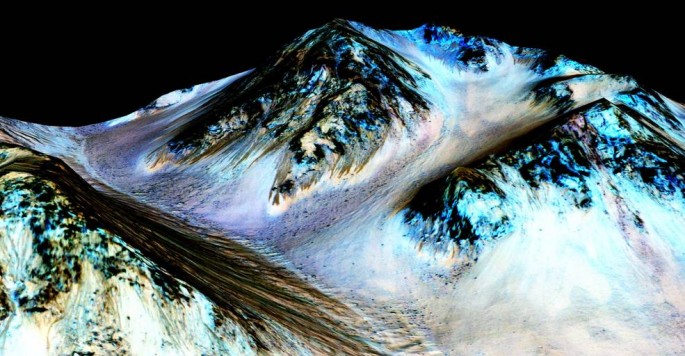During a crucial announcement on Monday, NASA reveals some compelling evidence of seasonal salty water flowing on Mars which is a pivotal finding that increases the possibility of life on the Red Planet, that could still exist today on the surface of the once thought dusty, barren alien world.
The U.S. space agency's discovery is based on some unusual surface streaks on the planet that apparently changes during Martian seasons. These water streaks appear on mountain slopes during warm seasons and can lengthen and then fade away in cooler seasons, based on evidence recorded by NASA's Mars Reconnaissance Orbiter.
According to NASA's planetary science director, Jim Green, Mars is no longer the dry, arid planet we thought in the past, as liquid water in now found on Mars.
In this new study, scientists have intensively studied and examined some curious lines on steep slopes, making up salty brine water streaks. These hydrated salt minerals found in the lines indicate how water formed these streaks, says co-author of the study Lujendra Ojha from the Georgia Institute of Technology in Atlanta.
NASA confirms that these findings are the strongest evidence yet that liquid water flows on present day Mars that can be a huge step closer to manned missions to Red Planet, where the space agency plans to carry out in the 2030s.
These salt minerals called perchlorates apparently contain water molecules in their composition. According to co-author of the study Alfred McEwen of the University of Arizona, evidence of this water is mostly found in wet soil, not free flowing water that is floating on the surface.
Scientists believe that the Red Planet once had flowing water existing in the surface however, the water found today still exists but is frozen underground. NASA released findings earlier this year regarding how an ocean once existed on more than half of Mars' northern hemisphere, with depths beyond 1.6 kilometers.
In this new study, the team from U.S. and France used a certain technique to extract more data from individual pixels from the images taken by the CRISM spectrometer of NASA's Orbiter where it successfully detected evidence of hydrated salt minerals in the surface streaks.
Green adds that NASA's Curiosity and Opportunity rovers that are currently exploring the surface of Mars have already detected more humidity in Martian air, as the soil is more moist than expected.
This new study is published in the journal Nature Geoscience.



























